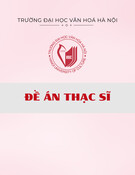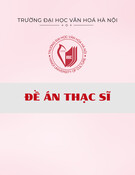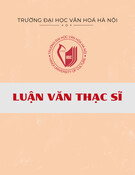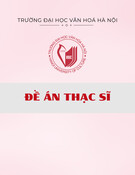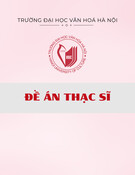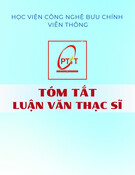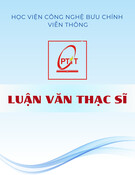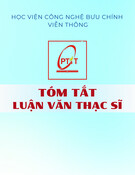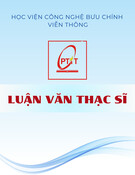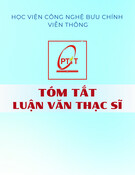1 2
This thesis has been completed at College of Foreign MINISTRY OF EDUCATION AND TRAINING UNIVERSITY OF DA NANG Languages, University of Danang.
Supervisor: LÊ TẤN THI, Ph. D.
Examiner 1: DƯƠNG BẠCH NHẬT, Ph. D.
Examiner 2: ĐINH THỊ MINH HIỀN, Ph. D.
PHẠM THỊ PHƯƠNG THI AN INVESTIGATION INTO COMMONLY USED STYLISTIC
This thesis will be defended at the Examination Council at
University of Danang.
Time: 17th April, 2012
DEVICES IN ENGLISH AND VIETNAMESE POLITICAL QUOTATIONS
Venue: University of Danang.
Field: THE ENGLISH LANGUAGE 60.22.15 Code:
This thesis is available for the purpose of reference at:
- Library of College of Foreign Languages, University of Danang.
M.A. THESIS IN THE ENGLISH LANGUAGE (A SUMMARY)
- The Information Resources Center, University of Danang.
DA NANG, 2012
1 2
Chapter 1 Commonly Used Stylistic Devices in English and Vietnamese
INTRODUCTION Political Quotations.
1.1. RATIONALE 1.2. AIMS AND OBJECTIVES
It is impossible to negate the importance of quotations in 1.2.1. Aims
language and in human life. Quotations bring us knowledge, This thesis mainly aims to provide the English learners with a
especially wisdom things, pieces of advice that many well-known basic knowledge of stylistic devices used in political quotations to
people draw from their life experiences. Most often a quotation is not enable them to understand political quotation thoroughly. Moreover,
only taken from literature, but also sentences from a speech, dialogue it also encourages them to use the stylistic device in speaking and
from a movie and lines from song lyrics are also used. All of the writing to make their speeches and written papers more beautiful and
reasons above motivate me to carry out this research. However, due attractive.
to the deficiency in knowledge, ability and time, I just dare to study 1.2.2. Objectives
political quotations in English and Vietnamese. This paper is designed to aim at the following objectives:
Along with its age-old history, Politics takes place in all types - To present stylistic devices commonly used in English and
of communities and then it plays an important role in human life. Vietnamese political quotations.
There are a large numbers of political quotations from speeches, - To suggest implications for the teaching and learning English
literature, poem, television, etc. All people want to have their own through political quotations.
persuasive political statements. As a result, stylistic devices seem to 1.3. RESEARCH QUESTIONS
be an effective way to make political quotations more and more Findings are discussed in relation to the following research
beautiful and attractive. The use of stylistic devices in political questions of the study:
quotations can create special effects, draw people’s attention and 1. What are the features of stylistic devices commonly used in
make them easy to remember. English political quotations?
As a teacher of English as a second language, I have noticed 2. What are the features of stylistic devices commonly used in
that using political quotations as a tool to teach English in general Vietnamese political quotations?
and stylistic devices in particular can bring great interest and positive 3. What are the similarities and differences in stylistic features
result to the learners as well as the teachers. This notice urges me to in English and Vietnamese political quotations?
make enquires about the fields. In order to contribute a small part in 1.4. SCOPE OF THE STUDY
the field of studying stylistics and using quotations in teaching This study focuses on the findings of stylistic features of some
English, I decide to carry out the research: An Investigation into commonly used stylistic devices in English and Vietnamese political
3 4
quotations namely simile, metaphor, hyperbole, repetition and Chapter 2
parallelism. LITERATURE REVIEW
1.5. SIGNIFICANCE OF THE STUDY 2.1. REVIEW OF PRIOR STUDIES
To some extent, this thesis is carried out hopefully to make a So far, there have been a lot of studies on the stylistic devices.
contribution to the teaching and learning English stylistics in general In Viet Nam, there are some investigations such as:
and of stylistic devices in political language in particular. In addition, Phan Thi Uyen Uyen (2006) studied some commonly stylistic
the learners are expected to be provided with some useful techniques devices in advertising language in English and Vietnamese
in writing. newspapers.
1.6. ORGANIZATION OF THE STUDY Nguyen Uy Dung (2010), in “An Investigation into Stylistic
The thesis consists of five main chapters. Devices in Political Speeches by US Presidents” studied the stylistic
o Chapter 1 is the introduction of the study, which includes the devices in political speeches by US presidents.
rationale, justification, the scope of the study, the research questions And Le Thi Lai (2010) investigated into stylistic devices used
and organization of the study. in English and Vietnamese texts describing natural scenery.
o Chapter 2, the literature review, presents the previous study 2.2 DEFINITION OF TERMS
related to the paper, the theoretical background of the study. General 2.2.1. Quotation and Stylistic Devices
views of quotations and some fundamental theoretical background to These are some terms related to this thesis. Here are some of
the study will also be presented. their definitions to make clearly about them.
o Chapter 3 is about the methods and procedures of the study. -Quotation is a group of words or a short piece of writing
It will describe the aims, the objectives of the study, then the
methodology, research design, data collection, data analysis. taken from a book, play, speech, etc. and repeated because it is interesting or useful. (8th Oxford Advanced Learner’s Dictionary)
According to Garperin, Stylistic Devices is a branch of general o Chapter 4: findings and discussion, is devoted to the findings
linguistics which is regarded as a language science. It deals with the of stylistic features of some stylistic devices commonly used in
result of the act of communication [1, p.12]. English and Vietnamese political quotations.
In my thesis, I define political quotations as quotations about o Chapter 5 includes the conclusion and the implications, the
politics or connected with the state, government or public affairs. limitations, and suggestions for using stylistic devices and further
Political quotations cannot be only stated by politicians but also by research.
celebrities such as a poet, a scientist, etc.
5 6
2.2.2. Quotation and Other Related Words Simile is a comparison between two different things that
- Adage resemble each other in at least one way. In formal prose the simile is
- Precept a device both of art and explanation, comparing an unfamiliar thing
- Maxim to some familiar things (an object, event, process, etc.) known to the
- Apophthegm reader [42]
- Aphorism So sánh tu từ là sự ñối chiếu hai hay nhiều ñối tượng khác
- Proverb loại, giống nhau một thuộc tính nào ñó nhằm biểu hiện một cách hình
2.3. THEORETICAL BACKGROUND ảnh, biểu cảm ñặc ñiểm của một ñối tượng [38, p.133]
2.3.1. Stylistic devices In the definition above, the simile markers such as: like, as,
2.3.1.1. Stylistic devices (also called Rhetoric) as…as, than, similar to, resembles, seems…in English or như, như là,
Stylistic Devices is a branch of general linguistics which is là, bao nhiêu...bấy nhiêu in Vietnamese were mentioned for the
regarded as a language science. It deals with the result of the act of illustration of simile. When you compare a noun to a noun, the simile
communication [5, p.12]. marker like in English as well as như in Vietnamese is usually used:
2.3.1.2. Functions of stylistic devices The café was like a battleship stripped for action.
An comprehensive explanation is brought out by V. M. (Ernest Hemingway, The Sun Also Rises)
Zirmunsky: “The justification of and the sense of each device lies in Tổ Quốc tôi như một con tàu
the wholeness of the artistic impression which the work of art as a Mũi thuyền ta ñó - mũi Cà Mau
self-contained thing produces on us. Each separate aesthetic fact, (Xuân Diệu, Mũi Cà Mau)
each poetical device finds its place in the system, the sounds and In brief, simile is a specific semantic trope in stylistics. The
sense of the words, the syntactical structures, the scheme of the plot, aim of simile is to reach for an expressive and figurative description
the compositional purport- all in equal degree express this wholeness about things compared.
2.3.3. Metaphor and find justification.”
A metaphor is an implied comparison is made between two 2.3.2. Simile
Simile is a specific semantic trope in stylistics, especially in unlike things that actually have something in common without using
rhetoric. We can find out the existence of simile in many fields of "like" or "as." A metaphor expresses the unfamiliar (the tenor) in
language: the language of literature, music, newspaper, terms of the familiar (the vehicle).
advertisements, etc.
7 8
A metaphor is a relation between the dictionary and contextual diễn ñạt ñể nâng lên gấp nhiều lần những thuộc tính của khách thể
logical meanings based on the affinity or similarity of certain hoặc hiện tượng nhằm mục ñích làm nổi bật bản chất của ñối tượng
properties or features of the two corresponding concepts. [5, p.136] cần miêu tả, gây ấn tượng ñặc biệt mạnh mẽ.” [33, p.46]
Ẩn dụ tu từ là cách cá nhân lâm thời lấy tên gọi biểu thị ñối Hyperbole appears very often in Vietnamese proverbs and folk
tượng này dùng ñể biểu thị ñối tượng kia dựa trên cơ sở của mối verses, so we can see that from the early time, people know how to
quan hệ liên tưởng về nét tương ñồng giữa hai ñối tượng [37] use this stylistic device to have a statement with high effect:
The example below will illustrate the structure of metaphor as Đêm tháng năm chưa nằm ñã sáng
well as its immense capability for expression. Ngày tháng mười chưa cười ñã tối.
In “You are the sunshine of my life”, the metaphor lies in the (Vietnamese folk verse)
noun sunshine: The tenor is the light of the happiness created by a In brief, hyperbole is a stylistic device in which emphasis is
certain person and the vehicle is the light of the sun and happiness is achieved through deliberate exaggeration. By emphasizing a truth by
the common ground. exaggerating it, hyperbole is a device which sharpens the reader’s
In another example in Vietnamese: ability to make a logical assessment of the utterance.
Bàn tay ta làm nên tất cả 2.3.5. Repetition
Có sức người sỏi ñá cũng thành cơm According to Galperin, “Repetition is also one of the devices
(Hoàng Trung Thông, Bài ca vỡ ñất) having its origin in the emotive language. Repetition when applied to
In summary, metaphor is a significant and common stylistic the logical language becomes simply an instrument of grammar. Its
device. It is also a potential land for further linguistic researches to origin is to be seen in the excitement accompanying the expression of
explore. a feeling being brought to its highest tension.” [5, p.211]
2.3.4. Hyperbole In Vietnamese, Lê Bá Hán, Trần Đình Sử, Nguyễn Khắc Phi
Hyperbole is a figure of speech that uses an exaggerated or give the following definition: “Điệp ngữ là một hình thức tu từ có
extravagant statement to create a strong emotional response. ñặc ñiểm: một từ, cụm từ, câu hoặc ñoạn thơ văn ñược lặp lại với
According to Galperin, “Hyperbole is deliberate dụng ý nhấn mạnh hoặc gây ấn tượng cho người ñọc, người nghe.”
overstatement or exaggeration, the aim of which is to intensify one of [29]
the features of the object in question to such a degree as will show its Here is an example of repetition:
utter absurdity”. [5, p.173] “Mad world! Mad kings! Mad composition!”
According to Đinh Trọng Lạc, “Phóng ñại (còn gọi là khoa (Shakespeare)
trương, thậm xưng, ngoa ngữ, cường ñiệu) là dùng từ ngữ hoặc cách
9 10
In summary, repetition is a widespread figure realized Chapter 3
especially in poetry and verse as well as one of the stylistic devices METHODOLOGY AND PROCEDURES
employed most in language in order to make it easier for readers and 3.1 RESEARCH DESIGN
listeners to remember the idea. Descriptive research is supposed to be the main method for the
2.3.6. Parallelism contrastive analysis because it is synthetic or analytic in its approach.
Being one of the common stylistic devices, parallelism or In addition, the study also uses quantitative and qualitative
parallel structures include word or phrase patterns that are similar. approaches as supporting methods.
Galperin defined that ‘Parallel construction is a device which 3.2 RESEARCH METHOD AND PROCEDURE
may be encountered not so much in the sentence as in the macro- Contrastive analysis is the main method of this study which
structure dealt with earlier, viz. the SPU and the paragraph. The helps us to discover the similarities as well as the differences between
necessary condition in parallel construction is identical, or similar, the two languages and then find out some implications for the
syntactical structure in two or more sentences or parts of sentence in creation and appreciation of political language containing stylistic
close succession.’ [5, p.208] devices.
In Vietnamese, parallelism is described as structure repetition,
differentiated with word and phrase repetition. Here are some The procedures of the research are as follows: • Choosing the research topic by reviewing the previous
examples of parallelism in English and Vietnamese: studies carefully.
When you are right you cannot be too radical; when you are
wrong, you cannot be too conservative. • Collecting and classifying data: read newspapers, books and political speeches, take notes of English and Vietnamese political
(Martin Luther King, Jr.) quotations and classify them by title
Tôi muốn tắt nắng ñi
• Comparing out the similarities and differences between English and Vietnamese commonly used stylistic devices in political Cho màu ñừng nhạt mất
quotations. Tôi muốn buộc gió lại
• Discussing the findings and suggesting some implications Cho hương ñừng bay ñi
(Xuân Diệu, Vội vàng) 3.3 POPULATION AND SAMPLE
In conclusion, parallelism is widely used in most of verbal The research examines 300 examples of political quotations
communication forms. It uses successive words, phrases, clauses (150 examples in English and 150 examples in Vietnamese). All
with the same or very similar grammatical structure. It is a rhetoric examples are selectively collected from English and Vietnamese
device that often appears in political language. newspapers, books and political speeches, etc.
11 12
3.4 DATA COLLECTION
The corpus comprises 300 samples in both languages, Chapter 4
collected from newspapers, books and political speeches as well as FINDINGS AND DISCUSSION
the Internet. 4.1. STYLISTIC FEATURES OF SOME COMMONLY USED
3.5 DATA ANALYSIS STYLISTIC DEVICES IN ENGLISH AND VIETNAMESE
The research is mainly carried out by the qualitative approach. POLITICAL QUOTATIONS
English is the source language and Vietnamese is the target one. The 4.1.1. Simile in English and Vietnamese Political Quotations
data analysis consists of the following steps: By classifying the standard of comparison, we can group the
• Examining the samples in both languages in terms of stylistic quotations using simile into 3 main groups:
devices. 1. Equational simile
• Classifying the samples into suitable categories, depending 2. Superior – inferior simile
on the frequency of occurrences in political quotations. 3. Superlative simile
• Analyzing the data contrastively to find out the similarities
and differences in both languages.
• Drawing conclusion of commonly used stylistic devices in 4.1.1.1. Equational • as...as and so…as : similar comparison In political quotations, the similar comparison as...as and
English and Vietnamese political quotations. so…as is often associated with negative word like no and nothing to
• Suggesting some implications for teaching and learning set off the main subjects, as in (1).
English through political quotations and further researches. (1) No party is as bad as its leaders.
3.6. RELIABILITY AND VALIDITY (Will Rogers)
In terms of reliability, the source selected to be investigated
is derived from books, newspapers, and the Internet in both English • A like B (2) Giving money and power to government is like giving
and Vietnamese. Therefore, the data source is highly reliable. whiskey and car keys to teenage boys.
In terms of validity, this study meets all required criteria. In (J. O'Rourke)
order to answer the three reseach questions, the observation and Besides, unlike is sometimes applied in political quotations to
investigation techniques have been chosen to be the main instruments show the differences between two things or people, as in (3).
for data collection. Besides,the investigation must follow the research (3) Unlike presidential administrations, problems rarely
design and the principles presented in Chapter 2 strictly to obtain the have terminal dates.
quality and to guarantee the validity and reliability of this study. (Dwight Eisenhower)
13 14
In Vietnamese, the simile markers are là and như, as in: In Vietnamese, the presence of the marker hơn leads us to the
(4) Tướng là chim ưng, quân dân là vịt. Lấy vịt nuôi chim superior comparison.
ưng thì có gì là lạ? (10) Không có gì quý hơn ñộc lập, tự do!
(Trần Khánh Dư) (Hồ Chí Minh)
Furthermore, the structure of comparison with negative The double comparison in Vietnamese is expressed by
word không bằng is also found out, as in (5). càng…càng. This kind of simile is applied very skillful and
(5) Ngồi yên ñợi giặc không bằng trước hãy ñem quân ra successfully in (11), a call for national resistance from a brilliant
phá thế mạnh của giặc. leader.
(Lý Thường Kiệt) (11) Hỡi ñồng bào cả nước! Chúng ta muốn hoà bình, chúng
ta ñã nhân nhượng. Nhưng chúng ta càng nhân nhượng, thực dân
Pháp càng lấn tới, vì chúng quyết tâm cướp nước ta một lần nữa! (…)
4.1.1.2. Superior – inferior simile • Superior simile (6) Half a truth is better than no politics. (Hồ Chí Minh)
(Gilbert Keith Chesterton) 4.1.1.3. Superlative
(7) I always considered statesmen to be more expendable The most commonly used superlative words are best and worst
than soldiers. thanks to their general meaning and special influence.
(Harry S. Truman) (12) The best government is that which teaches us to govern
The double comparison with the structure the+comparative, ourselves.
the +comparative also appears in political quotations. It can increase (Johann Wolfgang von Goethe)
the hearers and readers’ attention. (13) Chỉ có giai cấp công nhân là dũng cảm nhất, cách mạng
(8) The nations morals are like its teeth, the more decayed nhất, luôn luôn gan góc ñương ñầu với bọn ñế quốc thực dân.
they are the more it hurts to touch them. (Hồ Chí Minh)
(George Bernard Shaw) 4.1.2. Metaphor in English and Vietnamese Political
Quotations
• Inferior simile The double comparison is also used in inferior comparison As the most powerful means of creating images, metaphor is
with the same goal, as in (9). very popular in political language. In political quotations, metaphor is
Inferior simile is usually known by the word less. usually applied to talk about general affairs such as politics, war,
(9) The less government we have the better. politician, etc.
(Ralph Waldo Emerson)
15 16
(14) A politician is one that would circumvent God. Hyperbole is the use of exaggeration as a rhetorical device or
(William Shakespeare) figure of speech. Hyperbole used in political quotations can cause a
Moreover, metaphor in political quotation is also about parties mighty effect on the hearers and readers.
and the author usually expresses their view of them. (20) I have come to the conclusion that politics is too serious
(15) Democracy is an abuse of statistics. a matter to be left to the politicians.
(Jorge Borges) (Charles De Gaulle)
In our corpus, metaphor is often used with nouns. Following The author uses hyperbole skillfully to mock at the uselessness
of politicians. are some examples of this type of metaphor:
(16) Politics is a profession where the paths of glory lead (21) Political speech and writing are largely the defense of
the indefensible. but to the gravy.
(Billy Boy Franklin) (George Orwell)
Metaphor is not only used with nouns but also with verbs and Hyperbole in Vietnamese ones are often used to express the
adjectives as well. For example: strong will of Vietnamese celebrities. For example:
(17) Political image is like mixing cement. When it's wet, you (22) Bao giờ người Tây nhổ hết cỏ nước Nam thì mới hết
can move it around and shape it, but at some point it hardens and người Nam ñánh Tây.
there's almost nothing you can do to reshape it. (Nguyễn Trung Trực)
(Walter Mondale) 4.1.4. Repetition in English and Vietnamese Political
Metaphor always has two components: the tenor and the Quotations
vehicle. Sometimes the tenor is hidden and we must understand by Repetition is a stylistic device of using some sounds, words or
association. Following are some examples: phrases, aiming at logical emphasis, an emphasis necessary to fix the
(18) Wars are not paid for in wartime, the bill comes later. attention of the reader on the key words of the statement.
(Benjamin Franklin)
In Vietnamese:
(19) Vượt qua mùa ñông giá rét, chúng ta sẽ có một mùa 4.1.4.1. Repetition of Sounds • Rhyme: If the repetition of syllables is placed at the end of words, we
call rhyme as in the following examples: xuân ấm áp.
(Hồ Chí Minh) (23) Large legislative bodies resolve themselves into
4.1.3. Hyperbole in English and Vietnamese Political coteries, and coteries into jealousies.
(Napoleon Bonaparte) Quotations
17 18
(24) Dân ta phải biết sử ta. Cho tường gốc tích nước nhà Việt (29) A nation is not conquered which is perpetually to be
Nam. conquered.
(Hồ Chí Minh) (Edmund Burke)
(30) Các vua Hùng ñã có công dựng nước, Bác cháu ta phải
• Chime The type of repetition that keywords in a phrase begin with cùng nhau giữ lấy nước.
identical consonants is called chime. (Hồ Chí Minh)
(25) Resolved to ruin or to rule the state.
(John Dryden) • Apanalepsis The epanalepsis is a figure of speech defined by the repetition
(26) Ta thà làm quỷ nước Nam chứ không thèm làm vương of the initial word (or words) of a clause or sentence at the end of that
ñất Bắc same clause or sentence.
(Trần Bình Trọng) (31) Leaders don't create followers, they create more leaders.
(Tom Peters)
(32) Dân là dân nước, nước là nước dân.
(Hồ Chí Minh)
• Alliteration Alliteration is repetition of the same sound beginning several words in sequence. In my corpus, there are no occurrences of alliteration in English and Vietnamese political quotations.
• Anadiplosis Anadiplosis is the repetition of the last word of a preceding
clause.
4.1.4.2. Repetition of Words • Anaphora An anaphora is a repetition of a word or phrase at the (33) War begets quiet, quiet idleness, idleness disorder,
beginning of successive phrases, clauses or lines. disorder ruin; likewise ruin order, order virtue, virtue glory, and
(27) Segregation now, segregation tomorrow and good fortune.
segregation forever! (Walter Raleigh)
(George Wallace) (34) Tôi chỉ có một sự ham muốn, ham muốn tột bậc, là làm
(28) Sống không phải là ký sinh trùng của thế gian, sống ñể sao cho nước ta ñược hoàn toàn ñộc lập, dân ta ñược hoàn toàn tự do,
mưu ñồ một công cuộc hữu ích gì cho ñồng bào tổ quốc. ñồng bào ai cũng có cơm ăn áo mặc, ai cũng ñược học hành.
(Phan Chu Trinh) (Hồ Chí Minh)
4.1.5. Parallelism in English and Vietnamese Political
• Epiphora Epiphora is the repetition of the same word or words happens Quotations
at the end of successive phrases, clauses or sentences.
19 20
In language, parallelism is a forceful figure of speech. It is the 4.2. SIMILARITIES AND DIFFERENCES IN STYLISTIC
use of similar grammatical constructions to express ideas that are FEATURES IN ENGLISH AND VIETNAMESE
similar or equal in importance. In grammar, parallelism is a balance POLITICAL QUOTATIONS
of two or more similar words, phrases, or clauses. . 4.2.1. Similarities
(35) If a politician isn't doing it to his wife, then he's doing it Firstly, simple, vivid and attractive are similar features in
to his country. political language in English and Vietnamese.
(Amy Grant) Secondly, almost the stylistic devices used in English and
In (35), a humorous quotation becomes more humorous by Vietnamese political language have reached their functions.
reiterating the structure of the statement. Thirdly, as we can see from the analysis, there can be more
This figure of speech is sometimes used in the quotation about than one stylistic device in a political quotation. This situation
parties, as in (36), it compares and bring out the differences among happens in both languages.
At last, the functions of these stylistic devices are quite similar parties.
(36) Any 20 year-old who isn't a liberal doesn't have a in both languages.
heart, and any 40 year-old who isn't a conservative doesn't have a 4.2.2. Differences
Firstly, there are some differences in terms of structure in brain.
(Winston Churchill) stylistic devices.In English, simile is classified into three degrees but
in Vietnamese, the comparison structure as…as and inferior simile In Vietnamese:
(37) Đoàn kết, ñoàn kết, ñại ñoàn kết. Thành công, thành do not exist.
Secondly, the frequencies of occurrences of these stylistic công, ñại thành công.
(Hồ Chí Minh) devices in the two languages are different.
Parallelism in Vietnamese political quotations usually talks
about the important role of Vietnamese people to the country as well
as confirms the country’s guideline is to serving the benefit of
Vietnamese people
(38) Vì lợi nước, quên lợi nhà; vì lợi chung quên lợi riêng.
(Hồ Chí Minh)
21 22
Chapter 5
CONCLUSIONS AND IMPLICATIONS
5.1. CONCLUSIONS data, the frequencies of occurrence of some commonly used stylistic devices have been displayed. In Vietnamese political quotations, metaphor is usually used while in English ones, repetition is the most effective way for speakers. As has already stated a quotation is a group of words or a short
piece of writing taken from a book, play, speech, etc. and repeated
because it is interesting or useful. So a quotation must be vivid and
must have the quality that they can be easily remembered, especially
political quotations. As a result, a great variety of stylistic devices are
used. This thesis, an investigation into commonly used stylistic
devices in English and Vietnamese political quotations, is a
contrastive analysis, aims to find out some commonly used stylistic The stylistic devices have also been classified and arranged into different tables, according to their structure and frequencies. For example, simile is classified into three degrees such as equational simile, superior – inferior simile and superlative simile. Or repetition is divided into repetition of sounds and repetition of words. By classifying into tables, we can see the differences between the two languages. In English, there are three degrees of simile but in Vietnamese, as…as comparison and inferior simile does not exist. devices in English and Vietnamese political quotations as well as the
similarity and differences of these technique between two languages.
These commonly used stylistic devices are simile, metaphor,
hyperbole, repetition and parallelism.
The study is hoped to make some valuable contributions to the teaching and learning of English stylistics in general and of stylistic devices in political language in particular. Moreover, it can help English and Vietnamese learners get better understanding of political language as well as provide them some writing techniques in political language. 5.2. IMPLICATIONS
To some extent, this thesis is carried out hopefully to make a contribution to the teaching and learning English stylistics in general and of stylistic devices in political language in particular. In addition, the learners are expected to be provided with some useful techniques in writing. According to the result of the study, we would like to put forward some implications.
5.2.1. For the Part of English Learners
As regards methodology, both qualitative and quantitative methods are suitably used in the contrastive investigation. After analyzing the corpus of 300 samples, 150 in English and 150 in Vietnamese, I find that each stylistic device has the distinctive features and effect. Then the similarities and differences have been discovered through the contrastive analysis. In spite of some differences in terms of structure, the functions of these stylistic devices are quite similar in both languages. Each stylistic device also has the distinctive functions. For examples, simile and metaphor is mainly used to create vivid or graphic mental images. Repetition and parallelism is used to emphasize certain aspects. And hyperbole is frequently used for criticizing or exaggerating. But all stylistic devices have the purpose of arousing the listeners and readers’ interest or catching their attention. Besides, through the quantitative In general, to master a language as well as its stylistic devices are not an easy matter. Therefore, the result of this study may be beneficial to English learners. The findings of the study will help English learners enrich their knowledge of stylistic devices. Through
23 24
Stylistic devices are complicated and abstract problems of
stylistics. This means a research into this field is inevitable to meet
difficulties and having limitations. In political language, there are a
great number of stylistic devices. However, in this thesis, only some
commonly used stylistic devices are investigated. So many other
kinds of stylistic devices have not been cover, such as alliteration,
personification, inversion, climax, etc. the thesis, the learners will be sensitive to the beauty and the interestingness of political language. On the other hand, they can grasp some necessary strategies and techniques in writing speeches. Somehow the learners may have a better understanding of the culture of the two languages through the analyzing of political quotations. And their skills of writing and translating political speeches or statements can be enhanced. Day by day, their experience will be accumulated and help them learn more effectively and successfully. Furthermore, the materials supporting the thesis are rather 5.2.2. For the Part of English Teachers limited, especially Vietnamese samples, which make a challenge for For the language teachers, they often want to find out the most the researcher to reach a much more convincing conclusion. effective method to help their students master stylistic devices and For these limitations, I would highly appreciate any comments, the language. Stylistic devices appear in daily conversation, in advices and adjustments from who take interest in the topic in order literature and speeches but it is not an easy field. This thesis would to make this work more convincing and useful. give a suggestion on teaching stylistic devices through political 5.4. SUGGESTIONS FOR FURTHER RESEARCH quotations. Political quotations will serve as an effective tool in the This thesis has focused on some commonly used stylistic classroom. Working with political quotations at school can improve devices in English and Vietnamese political quotations. However, students’ learning experiences, their language skills and their each of these stylistic devices has not been analyzed clearly in terms understanding of themselves and the world. The teachers should of syntactic and pragmatics. So there are some further researches encourage their students to practicing stylistic devices through which can be taken into consideration: political quotations. It can improve their thinking and writing • Investigation into syntactic and pragmatics features of effectively. As a teacher of English as foreign language, I really repetition in English and Vietnamese political quotations. appreciate this method and have applied it into teaching English. • Investigation into syntactic and pragmatics features of Then I have got some good initial achievements. parallelism in English and Vietnamese political quotations. 5.3. LIMITATIONS • Investigation into syntactic and pragmatics features of Due to the lack of time, space as well as relevant materials, the metaphor in English and Vietnamese political quotations topic under study may not have been thoroughly discussed as it
should be.

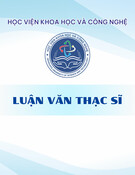

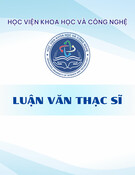
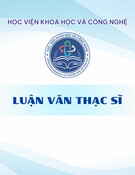
![Luận văn Thạc sĩ: Tổng hợp và đánh giá hoạt tính chống ung thư của hợp phần lai tetrahydro-beta-carboline và imidazo[1,5-a]pyridine](https://cdn.tailieu.vn/images/document/thumbnail/2025/20250816/vijiraiya/135x160/26811755333398.jpg)

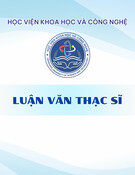
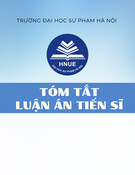
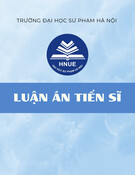
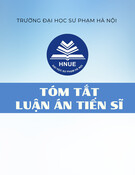



![Đề án Thạc sĩ: Tổ chức hoạt động văn hóa cho sinh viên Trường Cao đẳng Du lịch Hà Nội [Chuẩn nhất]](https://cdn.tailieu.vn/images/document/thumbnail/2025/20251202/kimphuong1001/135x160/91661764646353.jpg)
